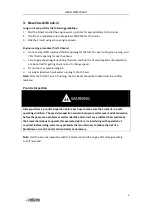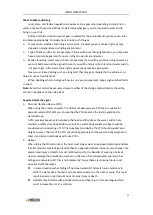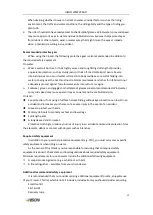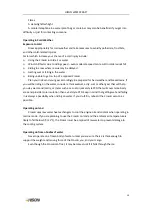
HISON WATERCRAFT
22
Riding with one hand or your feet incorrectly positioned will reduce the amount of control
that you have on the Crosski if you need to react to a situation or could cause you to lose balance
and fall off.
Turning
Do not release the throttle when trying to steer away from objects – you need trust to steer.
Maneuverability on water is reduced when the throttle is released and is completely lost when
the engine is turned off. A collision could result in severe injury or death.
On water, your Crosski is propelled and steered using a water jet. Turning the handlebars
rotates the jet thrust nozzle, controlling the Crosski’s direction. Steering control on water
depends on the combination of handlebar rotation and thrust from the nozzle. Unlike a car, the
Crosski requires some throttle to turn while in Marine mode.
The amount of throttle applied, in addition to handlebar position, will determine how
sharply the Crosski will turn. The steering efficiency of the Crosski may also be affected by loading
and wind/wave conditions.
Stopping
On water, your Crosski does not have brakes. The drag from the water will slow the
watercraft and bring it to a stop when the throttle is released. The brake levers on the handlebar
are for land use only and will have no effect while the Crosski is in Marine mode.
Do not shut off the engine while slowing down, in case thrust is needed to steer away from
an obstacle. Do not use the reverse lever to slow the Crosski on water.
While operating at full speed, the Crosski may require as much as 250 ft (76 m) to stop after
the throttle is released. Keep in mind that loading and wind/wave conditions may affect stopping
distance.
Always allow yourself plenty of room to stop by keeping a safe distance at all times.
Avoiding a Collision
Do not release the throttle when attempting to steer away from an obstacle. Throttle and jet
thrust are required to steer the watercraft. Often the best way to avoid a collision is to maintain
throttle and maneuver away from a potential hazard.
Always keep a constant lookout for people objects, and other watercraft on the water
especially before turning the Crosski. Be alert for conditions that may limit your visibility or block
your vision of others.
Do not wake or wave jump, ride the surf line or attempt to spray or splash others with your
Crosski. Such actions may cause you to lose control of your Crosski causing a collision or you may
misjudge the capabilities of the watercraft and your own riding skills and strike another
watercraft, fixed object or swimmer.
Your Crosski is capable of sharp turns and aggressive maneuvers. Unless it is an emergency,
do not attempt such maneuvers with other watercraft nearby, as it will make it hard for others to
predict where you are going and may increase the risk of collision.
Even if you have the “right-of-way” according to the Navigation Rules, all operators must
take positive action and alter course if a risk of collision exists. Whenever possible, take early and
effective action and always operate your Crosski at a safe speed and keep a safe distance away






























